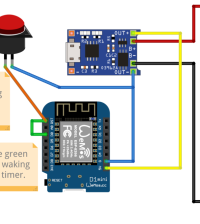- How to Adjust X and Y Axis Scale in Arduino Serial Plotter (No Extra Software Needed)Posted 6 months ago
- Elettronici Entusiasti: Inspiring Makers at Maker Faire Rome 2024Posted 6 months ago
- makeITcircular 2024 content launched – Part of Maker Faire Rome 2024Posted 8 months ago
- Application For Maker Faire Rome 2024: Deadline June 20thPosted 9 months ago
- Building a 3D Digital Clock with ArduinoPosted 1 year ago
- Creating a controller for Minecraft with realistic body movements using ArduinoPosted 1 year ago
- Snowflake with ArduinoPosted 1 year ago
- Holographic Christmas TreePosted 1 year ago
- Segstick: Build Your Own Self-Balancing Vehicle in Just 2 Days with ArduinoPosted 1 year ago
- ZSWatch: An Open-Source Smartwatch Project Based on the Zephyr Operating SystemPosted 1 year ago
PiGi: the Open Source Raspberry Pi Geiger Counter

Created by Hackster.io member Chrono, the aptly named PiGI takes the form of an open-source, plug and play modification for the Raspberry Pi Zero mini PC, which transforms it into a cheap and hackable Internet of Things geiger counter.
“The PiGI is designed & built as a simple open-source plug and play module for the Raspberry Pi to transform it into a cheap and hackable multi purpose geiger counter. It generates the necessary high voltage (up to 1000V) the GM tubes require to operate (typically 400-600V for beta/gamma GMTs).”
For every impulse the geiger tube registers the PiGI pulls a GPIO Pin of the Pi to ground (falling edge detection). On the Pi runs just a little daemon called counterd which waits for an interrupt to register the count and notify the display/audio/data-storage/network handler. That’s why it can also easily be connected to any other embedded/micro controller system like Arduinos, ATMegas or other embedded Linux ARM/MIPS systems with GPIO Inputs.
Features of the Raspberry Pi Geiger counter include :
– Efficient design – very low energy consumption – supplied by the Pi
– Simple circuit / Low BOM count
– Simple layout for easy hand-soldering (even for SMT beginners)
– Dual layer (top/bottom) only 3 vias – for easy DIY replication
– Very cheap design (Prototype costs per Module: <EUR15)
– Dual stackable for low/high dosis counting with 2 tubes
– Micro controller input protection (impulse inverter)
– Free & Open licencing: CERN OHL 1.1
– Plug and Play for Raspberry Pi
– Works with every uC with interrupts
















